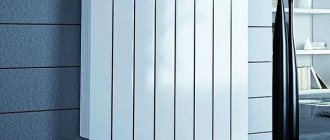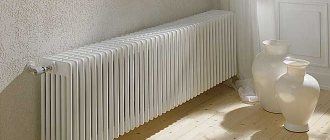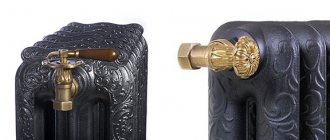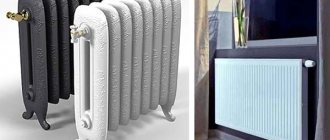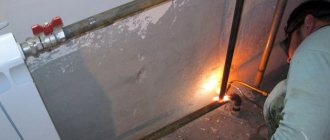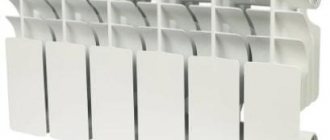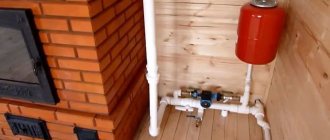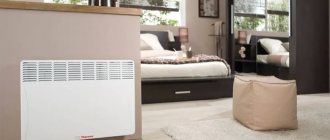Electric heating is an easy and affordable way to heat any room. An electric radiator is the main device of the system; the only necessary condition for its operation is the presence of a power source of sufficient power. Its design includes 2 functional parts:
- heat-dissipating element (metal radiator battery);
- heating element (heater).
A tubular electric heater (TEH) is used as a heating element in electric radiators, which is not fundamentally different from those used in heating devices and household appliances.
With the help of a heat-transfer element, heat is transferred to the room through convective and radiant heat exchange. Developers mainly use sectional batteries to unify the production process and adjust the rated power of individual models by selecting the number of sections.
To buy electric heating radiators which are best suited for the conditions of a particular apartment, you need to choose the right type, number of sections and type of coolant. Also, when choosing, you should pay attention to the functionality of the control unit and the availability of a set of parts for installation.
You can purchase either a fully assembled product or a kit consisting of a control unit and a heating element, which you can independently install in a separately purchased radiator battery.
Classification of electric radiators
Depending on the type of radiator grille, devices are divided into 2 types:
- liquid;
- liquidless.
In liquid models, sections have special channels that are filled with coolant. As in water heating radiators, heat is transferred from the liquid to the metal, after which heat exchange occurs between the sections and the air (convective heat exchange) and objects inside the room (radiant heat exchange). The difference compared to water heating is that in electric radiators there is no circulation of liquid, and its heating is carried out by a heating element.
Diagram and principle of operation of a liquid electric radiator.
It should be noted that liquid electric radiators use sections that are structurally identical to those used in water heating batteries. The radiator of several sections has upper and lower collectors with through holes. A heating element is installed in the lower one, and a Mayevsky tap is mounted in the upper one.
Monolithic liquid electric heater.
Liquid devices can either be connected to a water heating system or operate as a separate heating device. For this purpose, the coolant supply and discharge pipes are equipped with ball valves, which are closed to allow the device to operate in autonomous mode.
Advantages of liquid models
The use of liquid electric radiators as heating elements connected to a centralized water heating system allows you to obtain an effective and economical source of heat. During the heating season, the device is heated by the coolant circulating through the general system, and in the fall and spring, a heating element can be used to heat the liquid.
Models by number of sections.
To keep warm during the several cold weeks before the start of the heating season (and at the end), residents of houses and apartments with central heating purchase additional electrical heating appliances - oil radiators, convectors, infrared heaters and fan heaters. Installing liquid-type electric radiators allows you to avoid purchasing additional heating devices. At the same time, you can save not only money, but also the space needed to store devices during the warm season.
Which coolant is better?
Two types of liquid are used as a coolant in electric radiators - distilled water and non-freezing liquid based on ethylene glycol. When connected to a circulation heating system, the coolant with which the system is filled is used.
Electric radiator with remote control.
Distilled water is used in homes intended for permanent residence. If the building is used as temporary housing, there is a risk that the liquid inside the appliance may freeze, which may cause the product to malfunction. Therefore, in such cases it is filled with non-freezing liquid that can withstand temperatures down to -20 °C.
Conclusions and useful video on the topic
The video will clearly show you how the electric radiator works:
Every year the range of electric radiators is updated. Not only their technical characteristics are changing for the better, but also their design.
In order to make the best choice, you need to analyze the available information and, based on this, decide which technical indicators are suitable for your specific case.
Please write your comments in the block form located below the text of the article. Tell us about how you chose an electric radiator for use in a country house, office or apartment. Share useful information, ask questions, post photos on the topic.
Liquidless radiators
Unlike liquid-type radiators, in liquid-free ones heat transfer from the heating element is carried out directly to the metal heat-transmitting element, without the use of a coolant. They cannot be connected to water heating systems and are installed exclusively as an independent heating device.
Liquid-free wall-mounted radiators with different numbers of sections.
As in liquid radiators, batteries made of several metal sections are used as a heat-transfer element. These sections are not unified with models used in water heating systems. The absence of an intermediate link in the form of a coolant reduces the inertia of the radiator. Liquid-free devices heat up faster, but also cool down faster. They also have less weight, so they are easier to transport from one room to another. In the case of a permanent installation, the lighter weight allows the use of less durable mounts.
Experts recommend installing liquid electric radiators in premises for permanent residence, while inertia-free liquid-free devices are optimal for use in country houses and guest houses, winter recreation centers, retail outlets and mini-hotels.
Mounting options
One of the questions that interests the buyer before purchasing an electric heating radiator is the method of mounting it. Regardless of the model, there are three installation options:
- stationary wall hanging using anchors;
- installation on stands;
- mobile unit on wheels.
Electric radiator hung on the wall.
The methods of permanent installation do not differ from the suspension of traditional radiators of water heating systems. An electric radiator can be installed on any wall that can support its weight in working condition.
Option on wheeled supports.
Mobile installation allows you to easily carry (transport) it from place to place. Not all models are equipped with stands or wheels, so this issue needs to be clarified with the seller before making a purchase. If fasteners are not included in the kit, they can be purchased at an additional cost.
Stable wheel supports.
To provide the air circulation necessary for effective convective heat exchange, it must be installed with the following minimum distances to nearby surfaces:
- from the back wall to the wall – 30 mm;
- to the floor – 50 mm;
- to the window sill - 50 mm.
What are fan heaters
Most positive reviews about this type of product claim that such heating devices have good efficiency. The design includes a fan and a heating element.
- The heated air is evenly distributed using a fan around the perimeter of the room.
- The heating elements are made in the form of tubes or spirals. The design includes a thermostat.
- Its operating principle is based on turning off the heater after reaching the desired temperature.
This part is responsible for the rotation speed of the fan blades. Thanks to it, it is possible to prevent overheating of the device during long-term operation.
What is the best way to choose a radiator for a specific room?
On average, the rated power of one section is 0.13 kW. The required number of sections is selected depending on the area of the room according to Table 1. The data presented in the table is relevant for city apartments located in an insulated apartment building. If the room is located on the corner of the building, or the house is poorly insulated, the recommended number of sections should be looked at 1-2 lines below the specified area of the room.
Table 1 - Selection of an electric radiator depending on the area of the room
| Room area, m2 | Recommended number of sections | Rated power, kW | Electricity consumption, kW/hour |
| less than 4 | 3 | 0,39 | 0,10 |
| from 4 to 6 | 4 | 0,52 | 0,15 |
| from 6 to 8 | 5 | 0,65 | 0,20 |
| from 8 to 10 | 6 | 0,78 | 0,25 |
| from 10 to 12 | 7 | 0,91 | 0,30 |
| from 12 to 14 | 8 | 1,04 | 0,35 |
| from 14 to 16 | 9 | 1,17 | 0,40 |
| from 16 to 18 | 10 | 1,30 | 0,45 |
| from 18 to 20 | 11 | 1,43 | 0,50 |
| from 20 to 22 | 12 | 1,56 | 0,55 |
If the area of the room exceeds 22 meters, heating it requires the installation of two or three radiators. It is also recommended to increase the number of radiators if there is more than one window in the room. In this case, heating devices installed under each window create a thermal curtain, reducing the outflow of heat outside the room.
Premium electric convectors
A separate group among electric heaters are premium class models. They are distinguished by high build quality, long service life, and high energy efficiency.
The best premium electric convectors:
- Noirot CNX-4 1500. White stainless steel heater with an “unkillable” X-shaped heating element and mechanical control. The structure of the heating element is shell. There is protection against overheating, reliable moisture and dust protection. The heater has a thermostat of an innovative design. It is able to maintain precise temperatures - down to a tenth of a degree Celsius. The device is not afraid of power surges and operates at 150-242 V. Price: RUB 13,890.
- Noirot Spot E-5 2000. The device operates by convection and is designed to heat 25 square meters. m. The model has a discreet design and a small display showing the heating temperature of the room. Electronic, touch control. There are four operating modes. This heater has freeze protection. It heats the room quickly and almost silently. There is a long cable. Price: 14890 rub.
- Electrolux ECH/AS-2000 MR. Convection heater designed for a room up to 20 sq. m. Here there is a mechanical type of control and any installation option - wall or floor. The device has an option to turn off if it overheats. The device has low power consumption. There is air purification from odors. It is possible to eliminate over-humidification in a room without drying out the air. Price: 15880 rub.
- Nobo NFK 4S 15. This convector is designed for an area of 12-20 square meters. m. The device is equipped with a thermostat. Control is possible manually or through a special system. The convector is mounted on the wall with the brackets it comes with. The device has two operating modes. There is a shutdown option in case of overheating. The heater operates silently. Automatic operation and support of user-set temperature are provided. Price: 14290 rub.
comparison table
When choosing a wall heater for your dacha, compare their main parameters and characteristics. The first thing you should pay attention to is power, heated area and cost.
Table:
| Name | Power, W | Heater type | Heated area, sq. m | type of instalation | Cost, in rubles |
| Ballu BEC / ETER-1000 | 1000 | Convector | Up to 20 | Wall | 4500 |
| Ballu BIHP/R-1500 | 1500 | Convector + Infrared | Up to 20 | Wall | 8190 |
| Ballu BEC/EVU-2000 | 2000 | Convector | Up to 30 | Wall/floor | 4556 |
| Ballu BEP/EXT-2000 | 2000 | Convector | Up to 30 | Wall/floor | 12775 |
| Electrolux ECH/R-2500 T | 2500 | Convector | Up to 40 | Wall | 7790 |
Wall-mounted electric convectors are widely represented on the heater market. Among them, you can find models that are optimally suited for heating a specific cottage/room. The main thing is to correctly calculate the power of the device and provide it with a power supply line.
What material should I choose for radiator sections?
The vast majority of models are available with aluminum sections. This material has good thermal conductivity, and sections made from it are lightweight, affordable and attractive in appearance. When using an aluminum radiator as part of a circulation heating system, its internal surfaces are oxidized due to impurities contained in the coolant. Autonomous electric heaters use impurity-free distilled water or an ethylene glycol-based solution as a coolant, which do not react chemically with aluminum.
Aluminum electric radiator.
If desired, heating elements with an electronic control unit can be installed on radiators of any type - if you plan to use previously purchased heating batteries, or the use of an alternative material to aluminum is dictated by the interior design of the room. Thus, electric heating of the coolant can be implemented inside steel, bimetallic, cast iron sections, as well as design radiators made of glass or stone.
Advantages of energy-saving models
The advantages of a heating convector of this type include small overall dimensions and low weight - up to 10 kg. Easy to install and convenient to operate. The temperature is set using a mechanical thermostat, which is connected to electronic thermostats. A temperature sensor mounted on the wall allows you to accurately control the indoor temperature, which will be regulated by an electronic unit.
Currently, the manufacturer offers an option that you can install if you wish. This is a GSM device that allows you to control the device via a cell phone. A wide variety of colors, plus a great design.
temperature sensor
Modern electric radiators automatically adjust the heating intensity depending on the air temperature in the heated room. This parameter is measured using a temperature sensor, which can have two designs:
- built into the control unit housing;
- remote
If the radiator is intended to be installed permanently as the main source of heating, it is better to choose a model with a remote air temperature sensor. This option provides a more reliable temperature measurement, since the sensor is located at some distance from the radiator, in the immediate vicinity of which the air is always warmer than at a distance.
Where is the best place to mount the remote sensor?
If the device is equipped with a remote temperature sensor, it is mounted on the surface of the wall closest to the radiator. The distance from the sensor to the floor surface must be at least 1 meter, and to the radiator - at least 0.5 meters.
It is prohibited to place the sensor in a draft or in a place where there is direct sunlight, as this may affect the accuracy of the measurement. It is also not recommended to mount the sensor on the floor or windowsill.
What to look for when choosing electric radiators?
To choose a wall-mounted electric heater that best suits your needs, it is important to compare the parameters of the room, the stated needs and the capabilities of the equipment.
Video: features of choosing electric heating batteries
DO NOT BUY Radiators Until You See THIS!!!
Parameters that you need to pay attention to when choosing wall-mounted electric radiators:
- Device power. If you choose it incorrectly, it will either be too hot or, on the contrary, cold. The calculation can be done with the help of specialists, using ready-made formulas or an online calculator. For example, for a room with a ceiling height of 3 m, 1 kW of power for every 10 square meters is sufficient. m to obtain an output temperature of +20…+23°С. For regions with harsh winters, the recommended norm is 1.5 kW, for the southern regions - 0.5 kW per 10 sq. m. m.
- Installation method. There are stationary and mobile heaters. Some are hung on vertical structures, others on horizontal structures.
- heating element. Their service life is approximately 15 years. But there are models with longer operating times. Such heaters are more expensive, so they are rarely used for summer cottages.
- Nutrition. Electric wall heaters require a separate power line from the panel. It is recommended to purchase convectors that have an electronic thermostat. They are more sensitive to temperature fluctuations and can change the power of the radiator.
Operating modes
When choosing a radiator that is best suited for specific operating conditions, the buyer needs to pay attention to the number of modes of its operation, as well as a description of each mode. Modern radiators assume the following operating modes:
- Basic mode. The radiator heats up to the set temperature and then turns off. When the air temperature decreases by a certain amount (usually 0.5 - 1.0°C), the heating element comes back into operation.
- Economy mode. Tuned a few degrees lower than the main one. It turns on if the room is empty for some time. The difference between main and economy mode is configurable.
- Programmable mode. The radiator switches from mode to mode depending on the specified time of day. The program can be set for a specific time (day, week). The control unit allows you to configure several operating modes, and then easily switch between them.
Six-section radiator with programmable timer.
Oil heating devices
This type of heater is reliable, efficient and durable. Almost all models of oil-fired appliances are equipped with thermostats designed to control the degree of air heating, thereby saving energy.
Externally, these heaters are similar to water heating batteries, in which thin sections are connected to each other by tubes at the top and bottom. Thus, they form a closed circuit with an electric heating element located inside. It heats industrial oil, which has a high boiling point.
The body of oil heaters is made of durable metals. The device operates silently and does not burn oxygen in the room. As a result of the practical performance advantages of oil radiators, consumers are often tempted to purchase wall-mounted models, but they are not produced.
There are two reasons for this:
- Such devices have a lot of weight and it is difficult to find such strong mounts.
- If an oil radiator is placed on a wall, it will lose about half of the heat it produces because it radiates it in both directions.
Practice has shown that of all the options for an electric battery on the wall, convector models, whose operation is associated with natural circulation, have proven themselves to be the best.
Electrical safety measures
To ensure safe operation of the device, the following safety precautions must be observed:
- When connecting to the power supply, grounding must be used.
- It is not recommended to connect the device to the same outlet as other electrical appliances, as this may cause overloading of the wiring.
- The actual parameters of the electrical network should not exceed the limits specified in the operating instructions.
- Air humidity in the room should not exceed 80%.
- The radiator should be regularly wiped from dust and moisture should not be allowed to get into its electrical part.
The best convectors with thermostat
Convectors equipped with thermostats are functional and easy to use. With their help, you can quickly, safely, and without wasting electricity, heat a room of the appropriate size.
The best wall-mounted electric heaters with thermostat:
- Ballu Solo Turbo BEC/SMT-1000. This heater is compact and has a regulator through which the user can adjust the temperature at his discretion. The device is not afraid of accidental falls. The device can be hung on a wall or placed on legs. But additional fasteners have to be purchased separately. The case is protected from moisture, and the device itself has automatic shutdown systems. Price: 2890 rub.
- Hyuindai H-HV7-15-UI593. This heater is not only functional, but also has an attractive design with a futuristic style. The housing has many wide openings to ensure optimal air movement. This model has electronic control and a small display that displays information about the operating mode and temperature. The case has reliable moisture protection. The device has an automatic shutdown when overheating. Price: 5600 rub.
- Ballu Enzo BEC /EZER-1500. This heater has a simple but reliable design. The device is powerful and heats rooms up to 20 square meters. m. Control - electronic. All information needed by the user is displayed on the screen. The heater has a 24-hour timer, temperature control, and the housing is reliably protected from moisture. There is an automatic shutdown in case of accidental overturning and overheating. Price: 4800 rub.
Electricity consumption
This indicator should be considered in two groups. The power of liquid heating devices does not exceed 1 kW. Most often, manufacturers offer radiators of 500-800 W. This means that such a device will consume 20 kW of electricity per day. But if you configure it correctly, you can get a reduction of up to 12 kW.
With liquid-free ones it’s a little more difficult. Here the consumption per section is taken into account, which means that everything will depend on the number of sections present in the battery. Based on the fact that each section consumes 150-200 W, you can calculate the consumption of the radiator. Again, with the right setup, you can achieve a 40% reduction in consumption.



